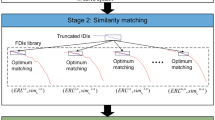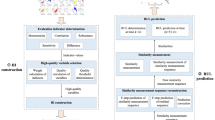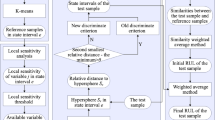Abstract
Remaining useful life (RUL) prediction is an effective method to ensure system safety and avoid catastrophe in applied intelligent perspective. A similarity-based method for RUL prediction based on operational reliability has been proposed in this paper to overcome the shortcomings existing in the conventional similarity-based RUL prediction method of devices. The first shortcoming is the construction difficulty of degradation index (DI) and the second shortcoming is the low accuracy of similarity measurement. First, a novel operational reliability fused index (ORI) was proposed by calculating offset distance and offset angle between current state and normal state of devices, and the index was used as the DI for life prediction. Then, a multi-factor similarity measurement method was proposed to select the most similarity samples and a novel similarity measurement and weight assigned method considering degradation degree was proposed based on the previous similarity measurement. Finally, the RUL was weighted predicted. The effectiveness of the proposed method was validated by implementing two cases.









Similar content being viewed by others
References
Lei Y, Li N, Gontarz S, Lin J, Radkowski S, Dybala J (2016) A model-based method for remaining useful life prediction of machinery. IEEE Trans Reliab 65:1314–1326
Lee J, Wu F, Zhao W, Ghaffari M, Liao L, Siegel D (2014) Prognostics and health management design for rotary machinery systems - Reviews, methodology and applications. Mech Syst Signal Process 42:314–334
Wang ZQ, Wang W, Hu CH, Si X S, Zhang W (2015) A prognostic-information-based order-replacement policy for a non-repairable critical system in service. IEEE Trans Reliab 64:721–728
Liu J, Wang W, Ma F, Yang YB, Yang CS (2012) A data-model-fusion prognostic framework for dynamic system state forecasting. Eng Appl Artif Intell 25:814–823
Zio E, Di Maio F (2010) A data-driven fuzzy approach for predicting the remaining useful life in dynamic failure scenarios of a nuclear system. Reliab Eng Syst Saf 95:49–57
Wang T, Yu J, Siegel D, Lee J (2008) A similarity-based prognostics approach for engineered systems. In: International conference on prognostics and health management, pp 4–9
Wang P, Youn BD, Hu C (2012) A generic probabilistic framework for structural health prognostics and uncertainty management. Mech Syst Signal Process 28:622–637
Camci F, Medjaher K, Zerhouni N, Nectoux P (2013) Feature evaluation for effective bearing prognostics. Qual Reliab Eng Int 29:477–486
Wang T (2010) Trajectory similarity based prediction for remaining useful life estimation. University of Cincinnati
Xiong X, Yang H, Cheng N, Li Q (2015) Remaining useful life prognostics of aircraft engines based on damage propagation modeling and data analysis. In: 2015 8th international symposium on computational intelligence design 2015, pp 143– 147
Zhao Z, Liang B, Wang X, Lu W (2017) Remaining useful life prediction of aircraft engine based on degradation pattern learning. Reliab Eng Syst Saf 164:74–83
Moghaddass R, Zuo MJ (2014) An integrated framework for online diagnostic and prognostic health monitoring using a multistate deterioration process. Reliab Eng Syst Saf 124:92– 104
Jia X, Jin C, Buzza M, Wang W, Lee J (2016) Wind turbine performance degradation assessment based on a novel similarity metric for machine performance curves. Renew Energy 99:1191–1201
Liu K, Gebraeel NZ, Shi J (2013) A data-level fusion model for developing composite health indices for degradation modeling and prognostic analysis. IEEE T Autom Sci Eng 10(3):652– 664
Wang R, Gao J, Gao Z, Gao X, Jiang H, Cui L (2015) Data fusion based phase space reconstruction from multi-time series. Intern J Database Theory Appl 8(6):101–110
Dai J, Das D, Ohadi M, Pecht M (2013) Reliability risk mitigation of free air cooling through prognostics and health management. Appl Energy 111:104–112
Lopez LD, Challa V, Pecht MG (2009) Assessing the reliability of elastomer sockets in temperature environments. IEEE Trans Device Mater Rel 9(1):80–86
Lee J, Wu F, Zhao W, Ghaffari M, Liao L, Siegel D (2014) Prognostics and health management design for rotary machinery systems—reviews, methodology and applications. Mech Syst Signal Process 42(1):314–334
Pham HT, Yang BS, Nguyen TT (2012) Machine performance degradation assessment and remaining useful life prediction using proportional hazard model and support vector machine. Mech Syst Signal Process 32:320–330
Lin D, Wiseman M, Banjevic D, Jardine AKS (2004) An approach to signal processing and condition-based maintenance for gearboxes subject to tooth failure. Mech Syst Signal Process 18:993–1007
Cai G, Chen X, Li B, Chen B, He Z (2012) Operation reliability assessment for cutting tools by applying a proportional covariate model to condition monitoring information. Sensors 12(10):2964–12987
Sun C, He Z, Cao H, Zhang Z, Chen X, Zuo MJ (2015) A non-probabilistic metric derived from condition information for operational reliability assessment of aero-engines. IEEE Trans Reliab 64(1):167–181
Bagheri B, Siegel D, Zhao W, Lee J (2015) A stochastic asset life prediction method for large fleet datasets in big data environment. In: ASME 2015 International mechanical engineering congress and exposition. American Society of Mechanical Engineers, pp V014T06A010–V014T06A010
Khelif R, Malinowski S, Chebel-Morello B, Zerhouni N (2014) RUL Prediction based on a new similarity-instance based approach. In: 2014 IEEE 23rd international symposium on industrial electronics (ISIE). IEEE, pp 2463–2468
Tao L, Lu C, Noktehdan A (2015) Similarity recognition of online data curves based on dynamic spatial time warping for the estimation of lithium-ion battery capacity. J Power Sources 293:751–759
Saxena A, Ieee M, Goebel K, Simon D, Eklund N (2008) Damage propagation modeling for aircraft engine prognostics. Response
Bin Z, Zhang L, Xu J (2016) Degradation feature selection for remaining useful life prediction of rolling element bearings. Qual Reliab Eng Int 32(2):547–554. https://doi.org/10.1002/qre.1771
Javed K, Gouriveau R, Zerhouni N, Nectoux P (2015) Enabling health monitoring approach based on vibration data for accurate prognostics. IEEE Trans Ind Electron 62:647–656
Kou G, Lin C (2014) A cosine maximization method for the priority vector derivation in AHP. Eur J Oper Res 235(1):225– 232
Ye J (2015) Improved cosine similarity measures of simplified neutrosophic sets for medical diagnoses. Artif Intell Med 63(3):171–179
Qian G, Sural S, Gu Y, Pramanik S (2004) Similarity between Euclidean and cosine angle distance for nearest neighbor queries. In: Proceedings of the 2004 ACM symposium on applied computing, pp 1232–1237
Simon H, Sick N (2016) Technological distance measures: new perspectives on nearby and far away. Scientometrics 107(3):1299–1320
Huang Z (1998) Extensions to the K-means algorithm for clustering large data sets with categorical values [J]. Data Min Knowl Disc 1998(2):283–304
Steinley D (2006) K-means clustering: a half-century synthesis. Brit J Math Stat Psy 59(1):1–34
Jiang H, Wang R, Gao J, Gao Z, Gao X (2017) Evidence fusion-based framework for condition evaluation of complex electromechanical system in process industry. Knowl-Based Syst
Xu P, Deng Y, Su X, Mahadevan S (2013) A new method to determine basic probability assignment from training data. Knowl-Based Syst 46:69–80. https://doi.org/10.1016/j.knosys.2013.03.005
Baraldi P, Di Maio F, Al-Dahidi S, Zio E, Mangili F (2017) Prediction of industrial equipment remaining useful life by fuzzy similarity and belief function theory. Expert Syst Appl 83:226–241
Saxena A, Goebel K (2008) Turbofan engine degradation simulation data set. NASA Ames Prognostics Data repository, NASA Ames Research Center, Moffett Field. http://ti.arc.nasa.gov/project/prognostic-data-repository
Shuhong R (2015) Aero-engine life prediction technology in condition based maintenance management (in chinese). Economic Science Press, Beijing
Acknowledgements
This research was supported by the First UHVAC GIL Special Project of China (Grant by No. SGJSJX00YJJS1602361) and project supported by the Sci-Tech Innovation Plan of Shaanxi (No. 2016KTCQ01-65).
Author information
Authors and Affiliations
Corresponding author
Rights and permissions
About this article
Cite this article
Zeming, L., Jianmin, G., Hongquan, J. et al. A similarity-based method for remaining useful life prediction based on operational reliability. Appl Intell 48, 2983–2995 (2018). https://doi.org/10.1007/s10489-017-1128-4
Published:
Issue Date:
DOI: https://doi.org/10.1007/s10489-017-1128-4




